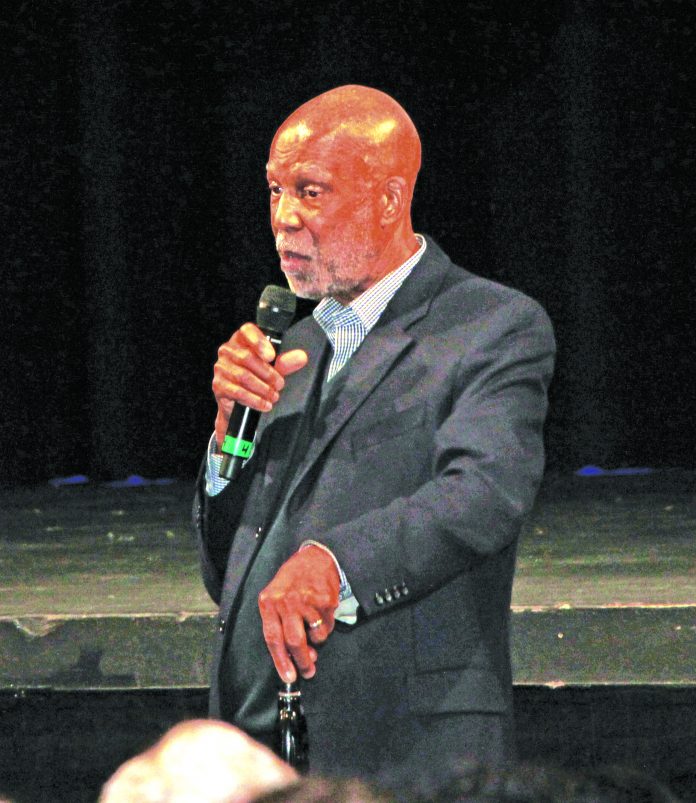
Terrence Roberts, of Little Rock 9, speaks to overflow crowd
Part 1 of 2
Woven together with a story of courage and personal responsibility, a civil rights icon this week laid forth a spellbinding tale of battling racism at the epicenter of the segregated south as students, parents, and teachers absorbed every word.
Dr. Terrence Roberts, then 15, was one of nine black teenagers that stepped forward in 1957 to face a torrent of danger to integrate Central High School in Little Rock, Arkansas. These students were then forever known as the “Little Rock 9.”
Facing an audience that filled the side rails and extended to the door of the lobby, Roberts engaged and kept them on the edge of their seats during a 90 minute lecture at the Los Alamitos High School Performing Arts Center.
Roberts traced racism back to 1619, citing the now defrocked doctrine of Manifest Destiny (that suggests God somehow ordained Europeans to own land from sea to shining sea). In fact, Roberts claims there is overwhelming evidence that “this country was founded on the principles of racism,” evidenced by what he says are the remnants playing out in the news every day.
Despite the depth of his convictions about the roots of racism, the arc of his own experience seemed to shed a positive light on a very dark chapter in the history of American education.
Three decades after the Civil War, Roberts said the U.S. Supreme Court decided in Plessy v. Ferguson that “separate but equal” facilities for whites and blacks in the South did not violate civil rights guaranteed under the 14th Amendment of the U.S. Constitution.
This court ruling set the stage for segregation, especially in the south, said Roberts as he told the story of his parents growing up in that generation.
In 1954, the nation and its southern states, were somewhat shocked by another Supreme Court decision in Brown v. Board of Education that outlawed discrimination, including the segregation of public schools.
“The law changed,” said Roberts, “but not much else.”
Nevertheless, two years after that decision, Roberts was one of 150 students with excellent grades invited by the Little Rock School Board to consider enrolling in Central High School, even as racists threatened harm to any black students to attend what was then an all-white high school.
Other students, and their parents, began to get cold feet after there were threats of “black blood” in the streets. By the fall of 1957, only nine students agreed to enroll in Central High.
Roberts then introduced the other eight members of the Little Rock 9 to the Los Al audience through a slide presentation.
“We didn’t really talk much about what was happening to us,” he said, though storm clouds were gathering as former civil rights lawyer Thurgood Marshall (who later became a Supreme Court justice) and Daisy Bates, a local NAACP leader, waded through legal and safety concerns.
Roberts spoke lovingly about his family, especially his mom, whom he said “was wise beyond her years.” As word began to filter out that he was one of the Little Rock 9, Roberts said the pressure became intense. His mother only told him in later life that someone had called, her, told her that Roberts had been “beaten” nearly to death. So she raced to find him, only to learn later nothing had really happened.
On the first day of school during the first week of September, 1957, the stage was set as the Little Rock 9 quickly became a proxy for desegregation across the segregated south. Orval Faubus, the state’s recently elected Governor, declared he would not allow the black students to attend Central High. “They just can’t come down here and cram this (integration) down our throats,” said Faubus, according to a contemporary article in the L.A. Times.
As Roberts and the others attempted to enter Central High, Faubus deployed the National Guard to prevent their entry. Following clashes and many violent arrests and two weeks later, the students had still not been able to enter the school. President Eisenhower met with Faubus. When that didn’t work, Eisenhower acted.
“This challenge must be met,” said President D. Eisenhower from the Oval Office, “and with such measures as to preserve for a people as a whole their lawfully protected rights.” The President ordered the rugged 101st Airborne Paratroopers to secure the school.
A few days later they arrived, secured the school and the Little Rock 9 made history as they began attending Central High.
Despite bullying, threats and other obstacles, Roberts said “eight of us were able to finish the year” One of the students gave in to rage and dumped her lunch on the head of a bully before being expelled, he added.
Even though the eight finished the full year, Gov. Faubus did not give in. Before the students could start school the next year, the Governor closed ALL the schools, so widespread integration could not occur. According to contemporary accounts, he railed against “naked judicial power.”
At that point, Roberts accepted an invitation to move out west with family and he says, “I took it.” Many years later, Roberts said he confronted Faubus on Good Morning America about blocking their entry into Central High. “At least he told me the truth,” said Roberts, noting that Faubus acknowledged he wanted to win another term. Faubus was re-elected, in fact, he served six two-years as the state’s governor.
Asked by a student what made him decide to become one of the Little Rock 9, Roberts said “I was aware that millions of people had lived before me and had died in this same cause fighting for freedom and liberty.”
According to Roberts, “we are who we are today not because of what we have done, but because of the foundation laid by people who came before us. We stand on their shoulders. Saying no to this opportunity would have been tantamount to turning around and spitting on the graves of those who had so valiantly fought for these freedoms and liberty. People need to see things in order to understand,” said Roberts.
Will racism ever die in America, another student inquired? “The ideology of racism will die out. It won’t die out of its own accord. But I think if, we the people, at some point choose to kill it off, it will,” said Roberts.
“The question is will we make that choice…when we say we will not tolerate racism. I’m waiting for that day,” he concluded.
Roberts then opened the forum to questions from students, teachers or parents, and his answers then became a lesson in life aimed at the students of all ages in the auditorium.
Drawing on experiences from his amazing life, Roberts provided examples to inspire the students, ranging from urging them to research for themselves our country’s “under investigated history,” imploring them to “enhance your vocabulary” and acquire positive “tools for life.”
Dr. Gregg Stone, principal of Los Alamitos High School, said he was “pleasantly surprised” by the overflow crowd, saying he invited Dr. Roberts before the recent incidents calling for more diversity in LAUSD. Stone said he had heard him speak in 2018 and invited him then.
“I didn’t know it would draw that big of an audience,” he said, adding that he did very little to promote the event outside of the system. “It was mostly word of mouth.”
Both he and incoming superintendent Dr. Andrew Pulver, also attending, thought Dr. Roberts delivered a “very positive message” to the students.
We will explore Dr. Robert’s exchange with the students and teachers of Los Alamitos in Part II next week.



